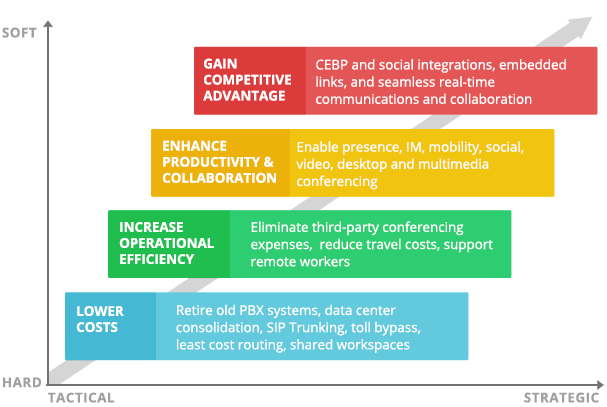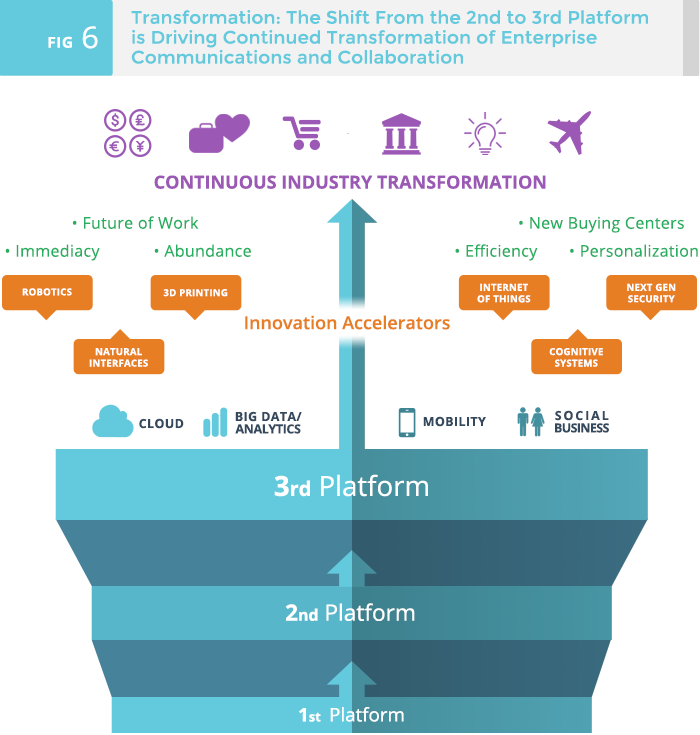The Role of Real-Time Communications and Collaboration in the Enterprise
The way enterprises work, communicate, and collaborate with co-workers, customers, partners, and suppliers is undergoing a rapid and dramatic transformation.
The proliferation of mobile devices and the BYOD phenomenon, the consumerization of IT, and the increasingly distributed, mobile, and virtual nature of workforces are key drivers of this shift. The growing popularity of videoconferencing and social business applications along with exploding demand for integrated, cloud-based solutions are further transforming how and where businesses work, communicate, and collaborate (see Figure 6).
Key Drivers
Proliferation of mobile devices and BYOD
Consumerization of IT
Increasingly distributed, mobile, and virtual workforce
Rise of videoconferencing and social business applications
Demand for integrated and cloud-based solutions
Enterprise communications and the enabling underlying infrastructure are also in the midst of a radical transformation from legacy TDM systems to new IP-enabled, applications-focused, and mobile-centric platforms.
These platforms bring together multiple solutions and applications including voice, IM, presence, conferencing, and messaging and enable seamless real-time communications and collaboration. Mobility, video, social business and communications-enabled business processes and apps are further contributing to the growing demand for solutions that seamlessly integrate UC capabilities with advanced voice and collaboration services and apps anywhere, anytime, and from any device.
VoIP usage in the enterprise is expanding as businesses migrate to managed, hosted, and cloud-based VoIP and UC&C solutions. Top reasons for VoIP adoption include cost savings, e.g., reducing opex, voice calling spend, and capex, followed by productivity gains (see Figure 7). Ease of management was particularly important to businesses with fewer than 100 employees, with small businesses ranking ease of management as a more important factor in the decision to implement VoIP than reducing voice calling or capex spend.
VoIP is also the underlying foundation for many of the technologies that enable real-time integrated communications and collaboration. Real-time technologies support specific business needs such as enabling a more mobile workforce, offer flexible delivery models to deploy newer capabilities such as cloud and hybrid solutions, and simplify the delivery and management of new voice and UC&C features by leveraging existing investments.
Enterprises are turning to real-time communications and collaboration, i.e., UC&C solutions in an effort to control and reduce costs, increase productivity, simplify the delivery and management of communications, and encourage collaboration both internally and externally with customers, partners, suppliers, and others. However, the reasons enterprises are investing in UC&C are evolving. Cost reduction — specifically reducing capex spend and increasing operational efficiency — remains a top-of-mind priority (see Figure 8), but increasing productivity and improving employee collaboration are gaining in importance, while cost reduction is waning (slightly).

Enterprises are also looking to UC&C to enable new applications and solve business process and collaboration challenges; consequently, many now realize that a business case focused on solving these challenges is often more compelling and likely to receive funding and support than one that does little more than cut costs. Additionally, real-time communications and collaboration solutions can help simplify management and delivery of services.
For instance, allowing a user to log into one system for email, IM, and conferencing using a single login account is an example of how real-time communications and collaboration enable simplified service delivery. Another benefit is the flexibility to deploy new capabilities and tools that enhance employee productivity and enable more effective communications and collaboration with co-workers, partners, suppliers, and customers.
In conclusion, the way enterprises work, communicate, and collaborate is rapidly evolving, as is the underlying enterprise communications infrastructure, which is transforming from legacy TDM systems to new IP-enabled, applications-focused, and mobile-centric platforms.
These platforms are bringing together solutions and applications including voice, IM, presence, conferencing, messaging, and mobility and enable seamless real-time communications and collaboration. At the same time, enterprises are moving beyond basic VoIP and UC solutions to real-time communications and collaboration solutions in an effort to reduce costs, increase productivity, and foster collaboration both internally and externally.
